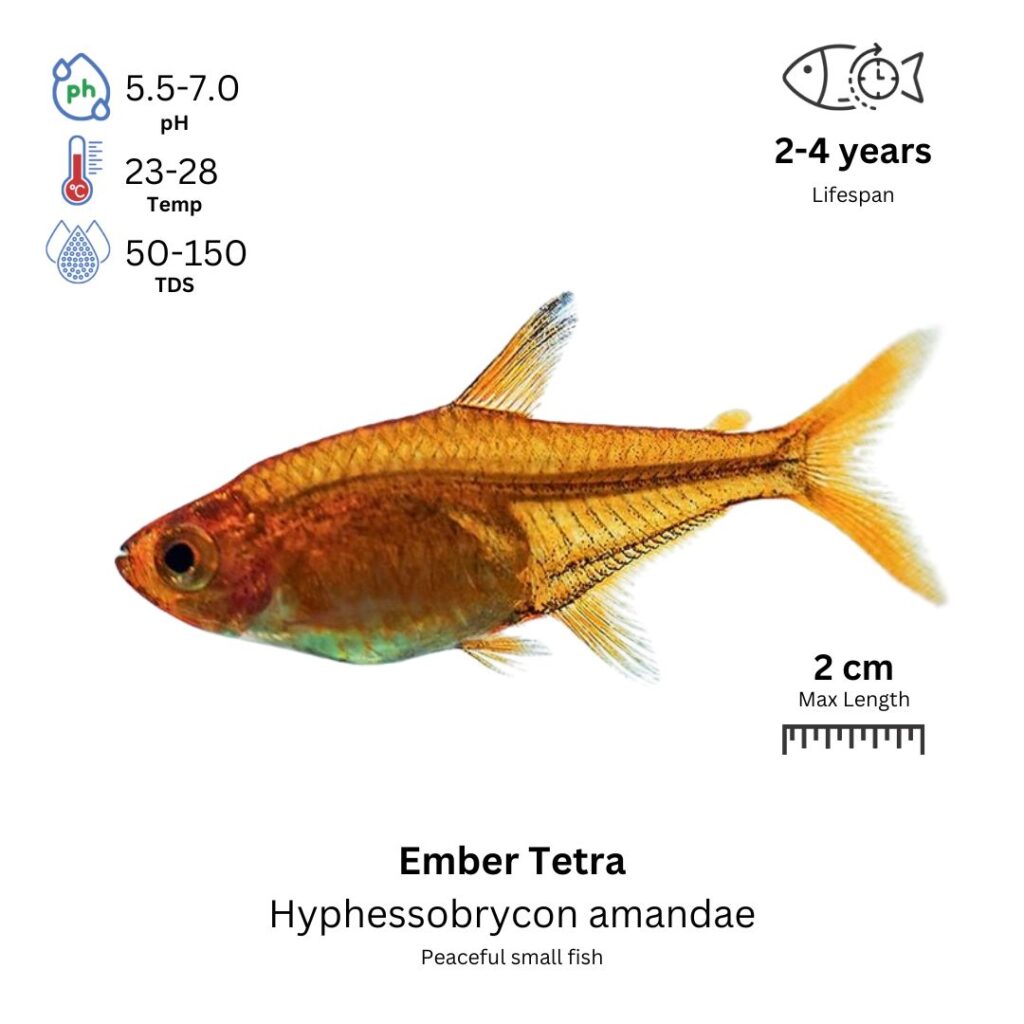Ember Tetra
Hyphessobrycon amandae

Description
The Ember Tetra is a small, vibrant fish known for its bright orange to red body, which resembles glowing embers. It has a slender, torpedo-shaped body with a slightly transparent tail and fins. This species is peaceful, active, and social, often seen swimming in groups, where their color intensifies. They are ideal for small to medium-sized aquariums and are relatively easy to care for. They are active swimmers, mostly staying near the middle and upper sections of the tank.
Habitat Origin:
Native to the rivers and streams of Brazil, particularly in the Rio de Janeiro area in South America.
Ideal Number
Ideal Number in Aquarium: At least 6 individuals (they are schooling fish and thrive in groups).
Favorite Food:

Ember Tetras are omnivores and will eat a variety of foods, including high-quality flake food, small live foods (like brine shrimp or daphnia), and frozen foods. They also enjoy small plant matter and algae.
Behavior:
These tetras are peaceful and do well in community tanks. They enjoy swimming in schools and feel safest when surrounded by several of their own kind. Ember Tetras are not aggressive and do not disturb plants or other tank mates, making them great for community aquariums with other peaceful species.
Special Care:
Ember Tetras prefer a well-planted aquarium with hiding places such as driftwood or rocks. They also do best in tanks with a gentle water flow. Being sensitive to water conditions, regular water changes and stable water parameters are crucial for keeping them healthy.
Compatibility with Other Fish:
Yes, Ember Tetras are great for community tanks with other peaceful fish, such as other tetras, small rasboras, and shrimp. They should be kept away from aggressive or larger fish that may view them as prey.
Breeding Tank Setup
A dedicated breeding tank is highly recommended for Ember Tetras to ensure stable water conditions and to prevent adults from eating eggs or fry. A 10-gallon (38-liter) tank is sufficient for a small breeding group, while a 20-gallon (75-liter) tank is preferable for multiple pairs. Ember Tetras thrive in soft, slightly acidic water with a pH of 6.0–7.0, a temperature between 24°C–28°C, and a hardness of 2–12 dGH. Use a sponge or gentle internal filter to maintain clean, oxygenated water without creating strong currents. The tank should include fine gravel or no substrate, and be planted with Java moss, Java fern, or Anubias to provide cover for eggs and fry. Moderate lighting (10–12 hours/day) is ideal—bright lighting should be avoided to reduce stress.
Conditioning the Breeders
To prepare Ember Tetras for breeding, offer a diverse and nutrient-rich diet. Feed them high-quality flakes or pellets as a staple, and supplement with protein-rich live or frozen foods like brine shrimp, daphnia, and microworms. Include occasional vegetable-based options such as spirulina or blanched spinach to support overall health. Conditioning should last for about 1–2 weeks. Perform weekly water changes (20–30%) to maintain high water quality, and consider a larger water change (up to 50%) just before breeding to stimulate spawning—slightly raising the temperature can also help trigger breeding behavior.
Spawning Process
Ember Tetras typically spawn in the early morning. The males display bright colors and chase the females during courtship. As egg scatterers, the female releases eggs throughout the tank, and the male fertilizes them. A healthy female can lay between 50–100 eggs per spawning session. After spawning, it is crucial to remove the adults from the tank to prevent them from consuming the eggs. Leaving the eggs in a quiet, undisturbed environment gives them the best chance to hatch successfully.
Fry Development
Eggs will hatch within 24–48 hours depending on water temperature. The fry are extremely small and should initially be fed infusoria or liquid fry food. Once slightly larger, they can be offered baby brine shrimp, microworms, or finely crushed flakes. Maintain water temperature within the ideal range and perform gentle, daily water changes (10–20%) to keep the water clean. Be cautious not to disturb the fry during maintenance, and avoid overfeeding to prevent ammonia buildup.
Breeding Tips
Ember Tetras reach breeding maturity at about 6 months but are best bred at 1 year for stronger results. Males are more vibrant in color and slimmer, while females are rounder with subtler hues, especially when gravid. To avoid stress that can inhibit breeding, ensure water parameters remain stable, avoid overcrowding, and maintain excellent water quality. A calm, planted, and well-maintained tank is key to successful breeding and fry development.
